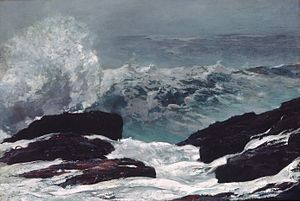
Andrew Newell Wyeth was a visual artist, primarily a realist painter, working predominantly in a regionalist style. He was one of the best-known U.S. artists of the middle 20th century.
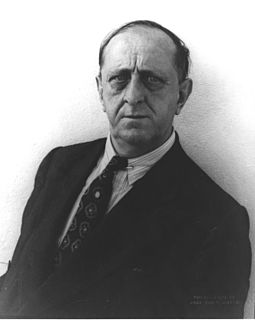
Marsden Hartley was an American Modernist painter, poet, and essayist.

The Butler Institute of American Art, located on Wick Avenue in Youngstown, Ohio, United States, was the first museum dedicated exclusively to American art. Established by local industrialist and philanthropist Joseph G. Butler, Jr., the museum has been operating pro bono since 1919. Dedicated in 1919, the original structure is a McKim, Mead and White architectural masterpiece listed on the National Register of Historic Places.

The Portland Museum of Art, or PMA, is the largest and oldest public art institution in the U.S. state of Maine. Founded as the Portland Society of Art in 1882. It is located in the downtown area known area The Arts District in Portland, Maine.

The Gulf Stream is an 1899 oil painting by Winslow Homer. It shows a man in a small dismasted rudderless fishing boat struggling against the waves of the sea, and was the artist's last statement on a theme that had interested him for more than a decade. Homer vacationed often in Florida, Cuba, and the Caribbean.

Bo Bartlett is an American realist painter currently working from both Columbus, Georgia and Wheaton Island, Maine.
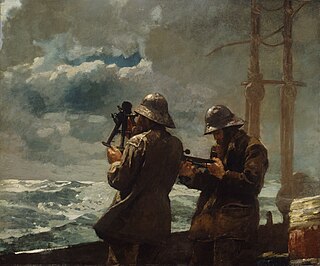
Eight Bells is an 1886 oil painting by the American artist Winslow Homer. It depicts two sailors determining their ship's latitude. It is one of Homer's best-known paintings and the last of his major paintings of the 1880s that dramatically chronicle man's relationship to the ocean.

The Winslow Homer Studio is the historic studio and home of the artist Winslow Homer, which is located on what is now Winslow Homer Road on Prouts Neck in Scarborough, Maine. Maine architect John Calvin Stevens altered and expanded an existing carriage house to suit Homer's needs in 1884, even moving the building 100 feet for added privacy from his brother's neighboring summer home. The most dramatic element is a balcony the width of the building, from which the artist often painted in winter. The building is 44 by 53 feet and two stories high, for a total of 2,200 square feet (200 m2). Homer lived and painted in the studio from 1884 until his death there in 1910.

Paul Hampden Dougherty was an American marine painter. Dougherty was recognized for his American Impressionism paintings of the coasts of Maine and Cornwall in the years after the turn of the 20th Century. His work has been described as bold and masculine, and he was best known for his many paintings of breakers crashing against rocky coasts and mountain landscapes. Dougherty also painted still lifes, created prints and sculpted.

John Currie Wilmerding Jr., is an American professor of art, collector, and curator, and is best known as a prolific author of books on American art.

The Boat Builders is an oil painting on panel by American landscape painter Winslow Homer, which is held in the collection of the Indianapolis Museum of Art (IMA), in Indianapolis, Indiana, United States.

The Bright Side is an oil painting by the American artist Winslow Homer. Painted in 1865, the concluding year of the American Civil War, the work depicts four African American Union Army teamsters sitting on the sunny side of a Sibley tent. The painting is in the collection of the Fine Arts Museums of San Francisco-(De Young)
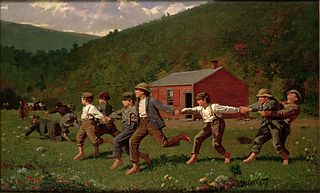
Snap the Whip is an 1872 oil painting by Winslow Homer. It depicts a group of children playing a game in a field in front of an old red schoolhouse. With more of America's population moving to cities, this portrait depicts the simplicity of rural agrarian life that Americans began to leave behind in the post-Civil war era.

The Fog Warning is one of several paintings on marine subjects by the late-19th-century American painter Winslow Homer (1836–1910). Together with The Herring Net and Breezing Up, painted the same year and also depicting the hard lives of fishermen in Maine, it is considered among his best works on such topics.
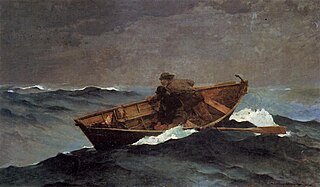
Lost on the Grand Banks (1885) is one of several paintings by the American painter Winslow Homer (1836–1910) on marine subjects. Together with The Herring Net and The Fog Warning, painted the same year, it depicts the hard lives of North Atlantic fishermen in Prouts Neck, Maine. The painting was bought in 1998 by Bill Gates, the then chairman of Microsoft. Gates reportedly paid $30 million for the seascape, at the time a record price for an American painting.
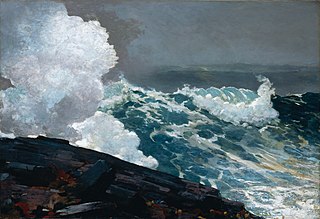
Northeaster is one of several paintings on marine subjects by the late-19th-century American painter Winslow Homer. Like The Fog Warning and Breezing Up, he created it during his time in Maine. It is on display in the Metropolitan Museum of Art in New York. Viewers are presented a struggle of elements between the sea and the rocky shore. Winslow Homer excelled in painting landscape paintings that depicted seascapes and mountain scenery.

Cannon Rock is an 1895 oil painting by Winslow Homer. It is part of the Metropolitan Museum of Art's collection.

Searchlight on Harbor Entrance, Santiago de Cuba is an early 20th century painting by American artist Winslow Homer. It is currently (2018) in the collection of the Metropolitan Museum of Art.

Moonlight, Wood Island Light is a late 19th century oil painting by American artist Winslow Homer. The painting is currently in the collection of the Metropolitan Museum of Art in New York.
